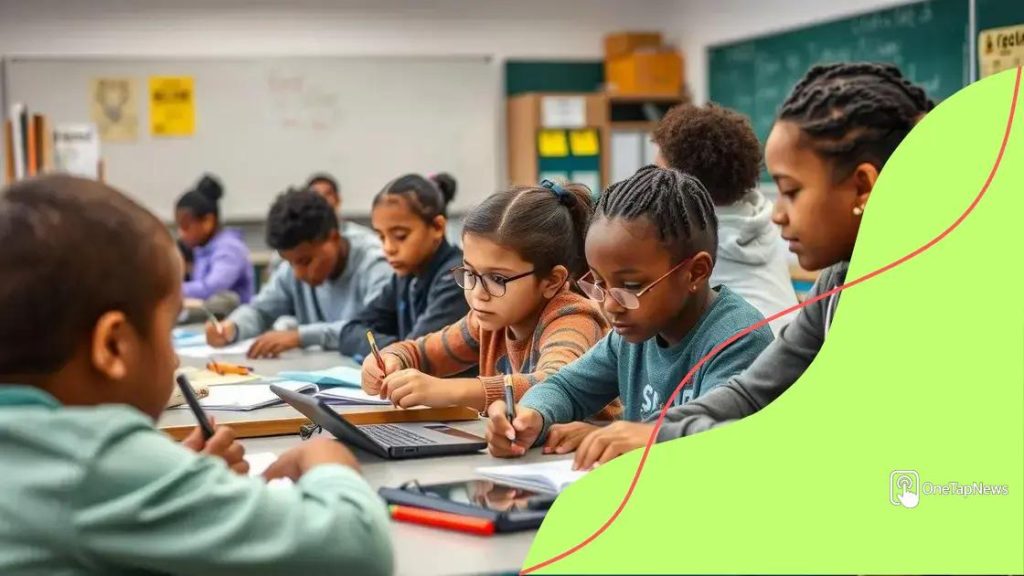Universal design for learning: making education accessible

Anúncios
Universal design for learning (UDL) is an educational framework that enhances inclusivity by providing flexible learning environments and diverse instructional methods to meet the needs of all students.
Universal design for learning offers exciting opportunities to redefine educational experiences. Have you ever thought about how inclusivity shapes learning environments? Let’s dive into this transformative approach!
Anúncios
Understanding universal design for learning
Understanding universal design for learning (UDL) is essential for creating an inclusive educational environment. This approach helps to meet the diverse needs of all learners by providing multiple means of engagement, representation, and action.
What is Universal Design for Learning?
At its core, UDL is a framework that guides the development of flexible learning environments. These environments adapt to the strengths and challenges of each student, promoting equal opportunities for success.
Key Principles of UDL
UDL focuses on three main principles: engagement, representation, and action and expression. Each principle plays a vital role in facilitating learning.
Anúncios
- Engagement: Engaging learners helps them stay motivated. It’s important to incorporate variety and choice in activities.
- Representation: Different learners take in information in various ways. Materials should be presented in multiple formats.
- Action and Expression: Students should be able to demonstrate what they know through various methods, like projects or presentations.
Incorporating these principles means acknowledging that students learn differently. For instance, some may be visual learners, while others might prefer auditory resources. This diversity in learning styles can be addressed through UDL strategies.
When implementing UDL, it’s crucial to create a flexible curriculum that encourages students to participate actively. This involvement fosters a deeper understanding of the subject matter. By learning within a UDL framework, students can better connect with content.
Benefits of Universal Design for Learning
The benefits of UDL extend beyond just inclusivity. They also enhance overall learning experiences. Some advantages include:
- Improved academic performance.
- Increased student motivation.
- Better retention of information.
By utilizing UDL, teachers are empowered to create lessons that resonate with all students. The flexibility offered by this approach invites collaboration and creativity in the classroom.
Key principles of universal design
The key principles of universal design are foundational to creating learning environments that cater to every student. Understanding these principles is crucial to fostering inclusivity in education.
Engagement
Engagement is about how students interact with the learning material. By offering various methods and tools, educators can stimulate interest. For example, incorporating technology can enhance participation and motivation.
Representation
Representation focuses on presenting information in multiple formats. Some students may grasp concepts better through visual aids, while others may benefit from verbal explanations. This diversity in presentation supports different learning styles.
- Visual aids: Charts and graphics can clarify complex ideas.
- Audio resources: Podcasts and audiobooks connect with auditory learners.
- Interactive content: Games and simulations engage learners effectively.
By utilizing various formats, teachers ensure that every student has access to learning materials that fit their preferences and strengths.
Action and Expression
Students should have multiple ways to demonstrate their understanding. This principle encourages creativity and personal expression in assessments. By allowing different types of projects, students can choose how they show what they know.
Classroom activities that allow for choice promote enthusiasm. For instance, students might opt to create a video, write an essay, or design a poster. This flexibility enables them to align tasks with their skills and interests.
By adhering to these key principles, educators can craft a more inclusive educational experience. This aligns directly with the goals of universal design for learning, ensuring that all students thrive.
Benefits for diverse learners

The benefits of universal design for learning (UDL) extend far beyond simple adaptability. This framework not only supports diverse learners but also enhances the educational experience for all.
Fostering Inclusivity
By implementing UDL, educators create a more inclusive environment. This approach recognizes that each learner has unique strengths and challenges. Everyone benefits when classrooms are designed to accommodate different needs.
Enhancing Engagement
Students often feel more motivated when they have choices in how they learn. UDL encourages educators to employ a variety of teaching methods, such as group work, technology integration, and hands-on activities. This variety keeps students engaged and prevents monotony.
- Choice: Letting students select their activities boosts interest.
- Flexibility: Offering different pathways to success caters to individual learning preferences.
- Collaboration: Group activities foster a sense of community and peer learning.
In this dynamic learning environment, students can better connect with the material, enhancing their overall comprehension.
Improving Academic Outcomes
Research shows that UDL leads to improved academic performance. When students can learn in ways that suit them best, their understanding deepens. By focusing on the strengths of each learner, educators can promote better retention of information.
Additionally, incorporating diverse instructional strategies helps students master content more effectively. This diverse approach makes learning more meaningful.
Building Confidence
Finally, UDL helps build self-confidence among students. When learners see themselves succeeding through personalized pathways, they develop a more positive self-image. This confidence often translates into a greater willingness to participate and take academic risks.
As we consider the benefits for diverse learners, it becomes clear that universal design for learning not only supports individual needs but also enriches the entire classroom experience.
Practical strategies for implementation
Implementing universal design for learning (UDL) requires practical strategies that educators can use in their classrooms. By applying these strategies, teachers can create an inclusive environment that meets diverse learner needs.
Assessing Learner Needs
The first step in implementation is to assess the unique needs of each student. This process involves observing students and gathering feedback on their learning preferences. Understanding how each learner engages with content helps tailor instructional approaches.
Creating Flexible Learning Environments
Flexibility is a hallmark of UDL. Classrooms should be organized to allow for movement and accessibility. For instance, arranging desks in collaborative groups fosters communication. Providing various seating options, such as standing desks or bean bags, can also cater to different preferences.
- Design collaborative spaces: Create areas where students can work together.
- Utilize technology: Integrate tablets and computers to access diverse resources.
- Ensure accessibility: Make sure that all materials are easily reachable for every student.
This classroom setup encourages participation and engagement from all learners.
Diverse Instructional Methods
Using a variety of teaching methods is essential. Incorporate visuals, hands-on activities, and discussions to reach different learning styles. For example, pair lectures with multimedia presentations that highlight key concepts. This mix not only keeps learners engaged but also caters to auditory and visual learners.
Moreover, consider offering different modes of assessment. Allow students to choose between writing reports, creating presentations, or producing video content. This choice motivates students to express their understanding in ways that feel comfortable to them.
Encouraging Collaboration
Collaboration is fundamental in a UDL framework. Encourage peer support and group projects. When students work together, they learn from each other and develop important social skills. Facilitate group roles that allow every student to contribute, ensuring a sense of belonging within the classroom.
By fostering relationships among students, you can create a supportive learning community focused on common goals.
Measuring success and impact
Measuring success and impact in universal design for learning (UDL) is crucial for understanding its effectiveness. By evaluating how well UDL strategies work, educators can make data-driven decisions to enhance learning experiences.
Setting Clear Goals
The first step in measurement is to set clear, achievable goals. These goals should relate to specific learning outcomes for students. When teachers define what success looks like, it becomes easier to track progress.
Gathering Data
Data collection is essential for understanding the impact of UDL. Educators can gather quantitative data, such as test scores and attendance rates, alongside qualitative feedback, like student and parent surveys. This combination of data provides a comprehensive view of student performance.
- Assessments: Use formative and summative assessments to gauge understanding.
- Student Feedback: Regularly ask students about their learning experiences.
- Peer Observations: Have colleagues observe and provide feedback on instructional practices.
These methods create a rich foundation for making informed adjustments to teaching practices.
Analyzing Results
Once data is collected, analysis is key to determining success. Look for trends and patterns in the data. For example, if a particular teaching method significantly improves student engagement, consider adopting it more widely.
Additionally, break down results by different student groups to identify any gaps. This analysis helps educators understand how well UDL addresses diverse learner needs.
Making Adjustments
Based on the data analysis, teachers can make necessary adjustments to their approaches. This might include modifying lesson plans, trying new teaching strategies, or incorporating additional resources to support student learning.
Continuously evaluating and adjusting practices ensures that the UDL framework remains effective and responsive to student needs.
universal design for learning offers teachers effective strategies to create inclusive classrooms. By focusing on individual learner needs, assessing their impact, and making adjustments, educators can enhance the learning experience for all students. Implementing these principles not only helps diverse learners thrive but also fosters a supportive environment. As educators, your efforts towards UDL make a significant difference in each student’s educational journey.
FAQ – Frequently Asked Questions about Universal Design for Learning
What is universal design for learning (UDL)?
Universal design for learning (UDL) is an educational framework that promotes inclusive teaching by addressing the diverse needs of all learners.
How can UDL benefit diverse learners?
UDL enhances engagement, improves academic outcomes, and builds confidence among learners by allowing them to express their understanding in varied ways.
What are some practical strategies for implementing UDL?
Practical strategies include assessing learner needs, creating flexible environments, using diverse instructional methods, and encouraging collaboration among students.
How do I measure the success of UDL in my classroom?
Measuring success can involve setting clear goals, gathering data through assessments and feedback, and analyzing results to make necessary adjustments.